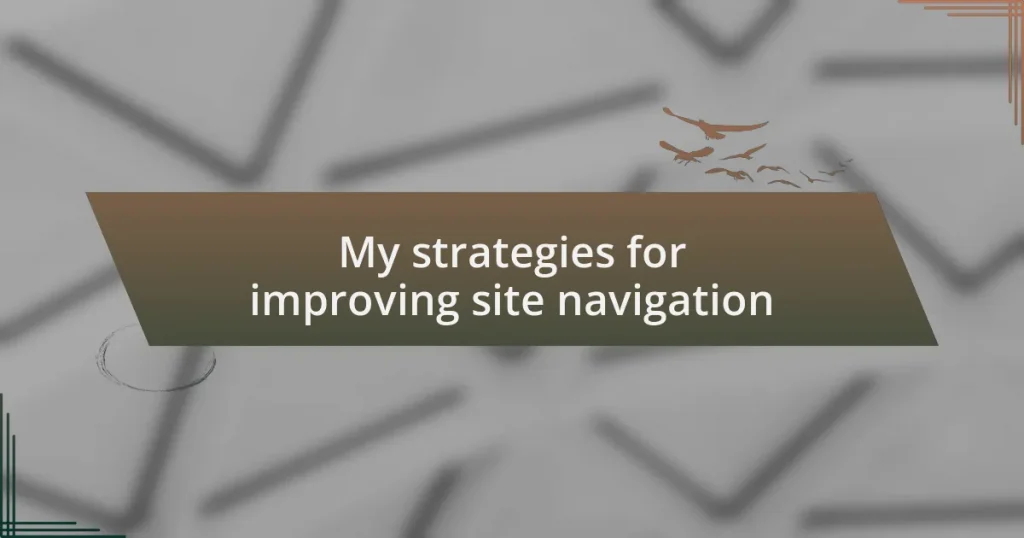Key takeaways:
- Effective site navigation enhances user satisfaction and prevents frustration, leading to a smoother browsing experience.
- Consistency in navigation design helps users build a mental map, reducing confusion as they explore a site.
- Strategies like simplified menu structures, the inclusion of a search bar, and breadcrumbs significantly improve usability.
- Well-structured navigation fosters trust and professionalism, encouraging users to stay and engage with the content.
Understanding site navigation principles
Effective site navigation is about more than just usability—it’s about creating a satisfying experience for the user. I remember redesigning a client’s website where users were consistently frustrated due to complicated navigation. By simplifying the menu structure and using clear labels, we connected with visitors and made their journey seamless. Can you imagine the relief of finding what you need without getting lost?
One crucial principle of site navigation is consistency. Whenever I see a site that changes its navigation across pages, it feels jarring, almost like wandering into an unfamiliar room over and over. Keeping navigation elements uniform helps users build a mental map of your site. Have you ever considered how frustrating it can be to retrace your steps when everything shifts?
Another dynamic aspect is the use of visual hierarchy. When I design a site, I prioritize the most important links, making them prominent. This strategy is especially effective when thinking about users who might be skimming. Don’t you want your visitors to easily spot essential information without feeling overwhelmed? By guiding their gaze, we enhance their overall experience, making navigation both intuitive and engaging.
Importance of effective site navigation
When I think about effective site navigation, it’s clear that it significantly influences how users interact with a website. There was a project I worked on where users were dropping off at an alarming rate. After diving deep into the analytics, we discovered that many felt lost and frustrated navigating the site. Improving navigation isn’t just about aesthetics; it’s about guiding users smoothly, helping them feel confident that they can find what they need. Isn’t it a relief to know that minor adjustments can lead to major increases in user satisfaction?
The emotional impact of seamless navigation cannot be underestimated. I once helped a nonprofit organization revamp their site after they lost potential donors due to confusing navigation. After implementing straightforward menus and clear pathways, their engagement skyrocketed. Witnessing the transformation in their visitors’ reactions was so rewarding—it’s peaceful to see users comfortably exploring, rather than battling their way through a maze. Can you imagine how uplifting that feels for both the user and the organization?
Moreover, effective site navigation contributes to building trust with users. When they encounter a well-structured layout, it signals professionalism and care. I distinctly recall a client who expressed gratitude after we simplified their navigation, saying it finally conveyed the reliable image they always aimed for. Users are more likely to stay and explore a site that feels secure and intuitive; isn’t that what every designer hopes to achieve?
Strategies for simplifying site navigation
One effective strategy for simplifying site navigation is to prioritize a clean and concise menu structure. In projects I’ve worked on, I found that limiting the number of menu items to five to seven main categories greatly reduces cognitive overload. I once revamped a site with an overwhelming number of links, and it transformed the browsing experience. Users began to navigate with purpose, rather than feeling paralyzed by too many choices—have you ever been in a similar situation?
Another approach that I highly recommend is incorporating a search bar prominently on the site. I remember a client who initially hesitated to add one but later realized how much easier it made navigating their extensive product catalog. It was like turning on a light in a dim room; suddenly, their customers felt empowered to find what they needed quickly. Isn’t it incredible how such a small feature can enhance the overall user experience?
Lastly, using breadcrumbs can provide users with a helpful trail of their navigation path. I worked with an e-commerce site that implemented this feature, and it profoundly affected customer satisfaction. Shoppers expressed relief at being able to backtrack easily without losing their place. It’s fascinating how these subtle aids can reduce frustration, isn’t it? By simplifying navigation this way, we foster a more user-friendly environment that encourages exploration and return visits.
